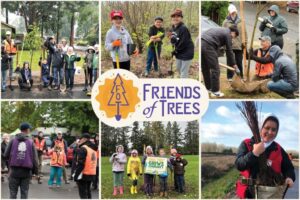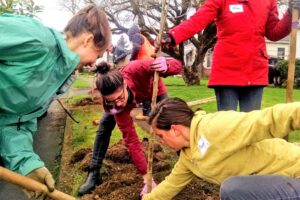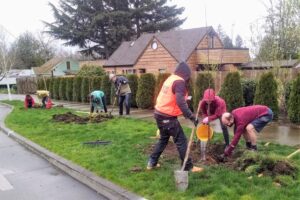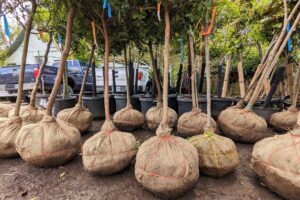Category: Tree research and studies
Friends of Trees in National Geographic

Friends of Trees’ extensive data about the trees we plant and care for was the basis for Dr. Geoffrey Donovan’s ground-breaking study about the life-saving potential of trees–and now that data and Friends of Trees are in National Geographic! (we bolded the Friends of Trees section for you)
The surprising way that millions of new trees could transform America
The U.S. is making a billion-dollar investment in planting and maintaining trees across the country to combat extreme heat and expand access to nature. But the benefits go way beyond that.
BYJEANNE DORIN MCDOWELL
When community groups planted 125 trees in two low-income neighborhoods in north central Detroit this past spring, changes were seen almost immediately. Residents began using the newly greened streets as a pedestrian corridor that allowed them to interact more with their neighbors. Trash collectors who routinely picked up garbage reported that littering had almost stopped completely.
“To me, it was validation that what we are hoping to accomplish with trees can and will work,” says Eric Candela, director of local government relations for American Forests, whose mission for more than 100 years has been to restore and protect the nation’s forest ecosystems.
In the next few months, Detroit will receive almost $10 million to plant more trees, along with many other cities and nonprofit groups in the U.S. that will get varying amounts to affect similar change. As part of the Inflation Reduction Act, the Biden Administration is awarding a billion dollars in grant money to communities throughout the country to plant trees to combat extreme heat and increase access to nature in cities and towns, where more than 84 percent of Americans live.
The money, which is the largest investment to date in urban and community forests, will go mostly to disadvantaged communities that grapple with “tree equity”—having enough trees so that everyone can experience their environmental, health, and economic benefits.
Adapting to climate change while helping fight it The positive climate impacts of trees are well-documented.
Trees, including parks and nature preserves, remove about 45 million tons of climate-warming carbon dioxide from the atmosphere each year, according to the Environmental Protection Agency (EPA). Already, they offset the pollution from about 10 million cars.
On a more local level, the can drastically influence the climate of a single neighborhood.
Trees are natural coolants and lower the risk of respiratory and heat-related illnesses such as those seen during this summer’s record heat wave. Streets with few trees are typically 10 degrees warmer and exacerbate “urban heat islands” that occur in areas with dense concentrations of pavement, concrete, and other materials that absorb and retain heat.
“Trees are a critical part of the infrastructure of cities and are as important as sidewalks and bridges,” says Benita Hussain, tree equity lead for American Forests, which was awarded $50 million in federal funding for tree planting and maintenance.
A growing body of research is finding that trees also provide an array of benefits associated with physical and mental health.
How trees make us healthier The calming effect of being around trees is familiar to anyone who has sat on a bench under a tree, walked down a tree-lined street, or experienced the respite of shade from a tree on a scorching hot day.
But research has also found that trees can help people live longer. A 2022 U.S. Forest Service study of 30 years of tree planting in Portland, Oregon by the nonprofit organization Friends of Trees found that one premature death was avoided for every 100 trees planted. Using data from the Oregon Health Authority, researchers found that in neighborhoods where more trees had been planted, death rates (per 100,000 persons) were lower. The association strengthened as trees aged and grew: the reduction in mortality rate associated with trees planted 11-15 years before was double that observed with trees planted in the preceding 1-5 years. This speaks to the potential public health benefits of preserving existing mature trees, which are associated with lower death rates.
In a 2020 report on Philadelphia’s goal to reach 30 percent tree canopy cover in every neighborhood by 2025, researchers estimated that 403 premature deaths overall, including 244 premature deaths in areas of lower socioeconomic status, could be prevented annually if the city were able to meet its goal. At the time, the tree canopy cover in disadvantaged areas was about 17 percent.
Trees make us happier too Numerous studies show that being around trees reduces blood pressure as well as the stress-related hormones cortisol and adrenaline. Research has also found that increasing the number of urban trees is associated with a statistically significant improvement in mental health conditions, especially for people living in disadvantaged areas. A 2015 study monitored participants’ heart rates to measure acute stress responses in individuals who walked past vacant lots in Philadelphia before and after they were filled with trees. They found that looking at greener lots decreased heart rate.
“Trees calm us down, improve our mood and stress levels, and lower blood pressure,” says Michelle Kondo, a U.S. Forest Service social scientist who studies the health benefits of trees.
Being in nature helps people bounce back faster from stress, and being around trees helps restore attention. It’s a mini-rest period that reduces the body’s arousal mechanism and returns it to a more restful state, thereby stabilizing mood.
“We spend so much time staring at computer screens, but being in nature allows us to replenish that cognitive reserve,” says Peter James, an environmental health expert at Harvard’s T.H. Chan School of Public Health. “Staring at trees, even watching leaves scatter in the wind allows our brains to be ready for the next cognitive task.”
Similarly, trees can help children with ADHD. Linda Powers Tomasso, an environmental scientist at the T.H. Chan School of Public Health, asserts that this is especially useful in helping children with attentional issues and that trees can help them focus more.
Transforming tree-less communities Studies confirm that planting trees fosters a sense of community and civic pride, especially in areas that have been historically underinvested in.
“Psychologically, people feel ‘someone is paying attention to my neighborhood,’” says Tomasso. ‘”Some entity cares about my neighborhood. I matter.’”
The presence of trees in urban areas facilitates outdoor recreation, physical activity, and socializing, which can reduce lonelines.
“Being near trees softens people in disposition and makes them more empathetic to others,” says Kondo.
Trees can even reduce crime and gun violence.
A recent University of Pennsylvania study examining gun violence and tree cover in six U.S. cities found that higher neighborhood income was strongly linked to lower firearm violence over a five-year period. A 2018 study on cleaning-and-greening vacant lots in neighborhoods with residents living below the poverty line found a 29 percent reduction in gun violence around lots that were greened with trees compared to vacant lots.
The process of planting and maintaining urban trees can also bring jobs to a community and lead to the creation of a local environmental workforce.
According to Marcos Trinidad, senior director of forestry for Southern California’s Tree People, which received $8 million in federal funding, upcoming tree plantings throughout parts of Southern California will require many workers—for planting new trees, pruning , and removing older trees. In fact, funding comes at a time when millions of trees are being lost to wildfires, drought, urban development, and a lack of good tree care.
“I’m not a psychologist,” adds Trinidad. “But when I’m around trees, and I can walk down a street lined with trees…, it creates this overall feeling of joy.”
The Lifesaving Potential of Trees
A new scientific study associates tree planting with fewer deaths
At Friends of Trees, we champion the many benefits of urban trees: they clean the air and water, provide wildlife habitat, and shade our homes and streets. Trees improve our environment, but they also improve our quality of life. Dr. Geoffrey Donovan, a researcher with the United States Forest Service, wanted to investigate one step further — do trees save lives?
In 2013, Donovan conducted a study that associated a loss of trees from emerald ash borer with a higher rate of mortality for people that lived in those places that lost trees.
“I wanted to see if the inverse was true,” Donovan says. “Would planting more trees be associated with fewer deaths?”
Luckily, Donovan had access to years worth of tree planting data from Friends of Trees. Specifically, he used the planting data from the nearly 50,000 trees that Friends of Trees planted in Portland neighborhoods since 1990.

The new study, published in December 2022 in the journal Environmental International, found that each tree planted was associated with significant reductions in non-accidental and cardiovascular mortality. To account for other possible explanations for the mortality rate like race, education, and income, the statistical models incorporated data from the American Community Survey.
Looking at all 140 census tracts in Portland, Donovan showed that on average, 11.7 new trees in each neighborhood were associated with 15.6 fewer non-accidental deaths and five fewer cardiovascular deaths each year.
“It’s incredible,” says Friends of Trees Executive Director Yashar Vasef. “We know that trees can transform a community, but it’s really meaningful to see the data analysis.”
As the trees mature, their benefit grows too. Trees planted within the past 11-15 years had twice the impact of trees planted within the last five.
“The association is unequivocal, but the study has its limitations,” Donovan says. The study stops short of proving a definitive causal relationship between planting trees and fewer deaths, but Donovan expressed confidence in his findings, saying, “we do think it’s likely that trees are saving lives in Portland, because we accounted for a lot of other explanations.”
One way the study was able to account for other explanations was by focusing on the change in trees compared to the change in mortality rate. The totality of canopy can vary widely by neighborhood, but each new tree can make a difference regardless of where it’s planted.
The study went on to associate the reduced death rate with an incredible economic benefit, based on the EPA’s statistical value of a human life. Planting one tree in each of the 140 census tracts in Portland is associated with a reduction in non-accidental death of 1.33, which has a statistical value of $14.2 million. To plant and care for those 140 trees would cost just $3,000-$13,000.
“In short, trees are cheap and human lives are valuable,” Donovan says. “The public money that went to Friends of Trees generated remarkable rates of return.”

The City of Portland’s Bureau of Environmental Services did not renew its partnership with Friends of Trees that added 40,000 street and yard trees in Portland over 14 years. Friends of Trees is still planting in Northeast Portland as part of the Clean Air Canopy project, and in 17 municipalities throughout Western Oregon and Southwest Washington.
“Beyond the incredible findings, this study points to the importance of robust data collection,” Yashar says. “By diligently tracking this information, we are creating huge data sets that scientists can use in their research. And then that research can help us do our work better.” Friends of Trees logs the location, species, and planting date of every tree it plants.
“Friends of Trees data has been enormously helpful to me,” Donovan says. “I would love to see even closer collaboration between practitioners and scientists.”

